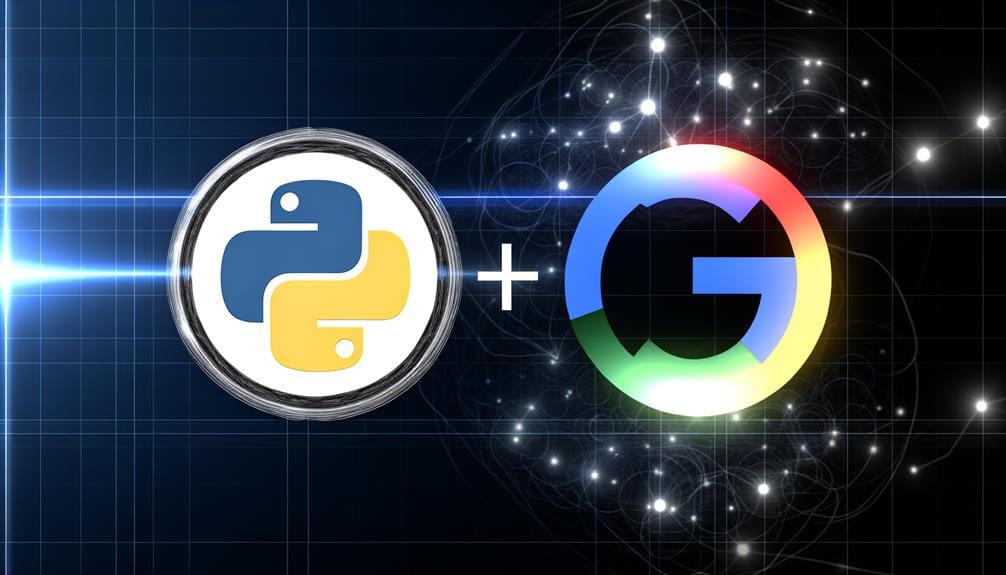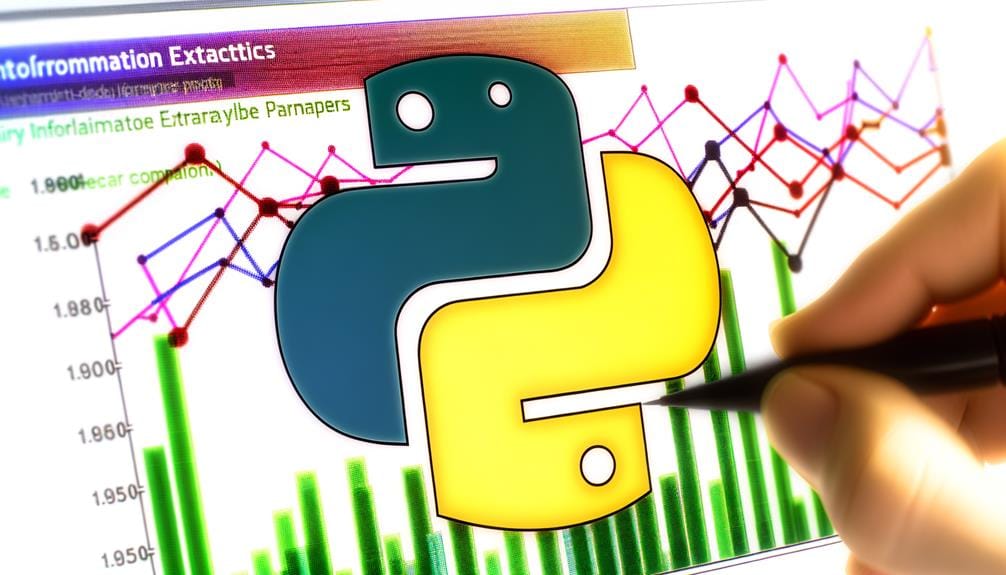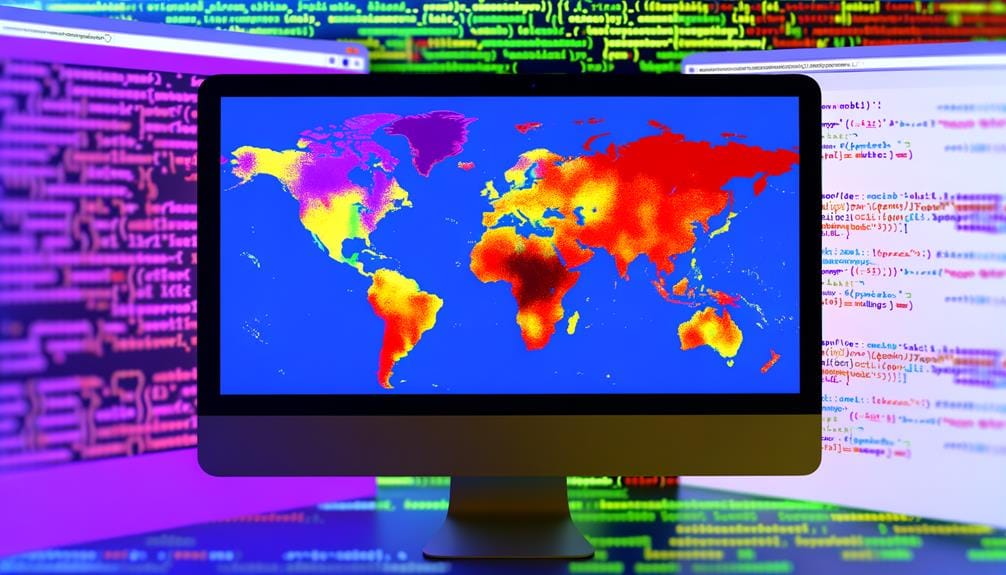We'll use PyTrends, an unofficial Python library, to connect to Google Trends and extract search trend data. Installation's simple: just type `pip install pytrends`. We set parameters for precise data extraction and define keywords for trend analysis using methods like `interest_over_time()`. Then, harnessing Plotly's graphing capabilities, we create dynamic, interactive visualizations of these trends. Embrace this powerful combination to analyse global search trends, understand hourly search patterns, and study regional search interests. Our journey doesn't stop here. Stick around, and we'll uncover how to optimize SEO strategies using PyTrends' related search extraction.
Key Takeaways
- Install PyTrends using the command `pip install pytrends` to leverage the Google Trends API for trend analysis.
- Establish a connection to Google Trends using the TrendReq() method and configure proxies for efficient data extraction.
- Define keywords and create a payload with appropriate parameters for extracting trending data.
- Use the `interest_over_time()` method in PyTrends to get the interest over time for the defined keywords.
- Visualize the extracted trends data using Plotly, a Python library for creating dynamic and interactive dashboards.
Understanding PyTrends and Installation
Diving into the world of PyTrends, it's the Python library that harnesses the power of Google Trends API, streamlining data production and interactive plot creation for trend analysis. With its bounty of pytrends features, we can analyze global search trends, extract data by industry or geography, and even track low search volume countries. It's a powerful tool in our data analysis arsenal. To get started, we'll need to run through a simple pytrends setup tutorial. First, we ensure the necessary Python environment dependencies are installed. Then, using the command `pip install pytrends`, we install the library. With PyTrends installed, we're ready to plunge into the deep world of search trend analysis, locating related queries and analyzing key search data.
Connecting to Google Trends With Pytrend

Now that we have PyTrends installed, let's explore how to connect to Google Trends and start extracting valuable data. The library provides a functionality to establish a connection using the TrendReq() method. Request handling is critical to ensure smooth data extraction; thus, we need to correctly set up proxies configuration. By utilizing proxies, we can make more requests and avoid potential blocking.
Next, trend data analysis is where PyTrends truly shines. The library allows us to extract and analyze Google Trends data, opening a multitude of possibilities for insights. Furthermore, PyTrends enables us to create interactive plots to visualize these trends, making the data more understandable and actionable. So, let's dive right in and start harnessing the power of Google Trends with PyTrends.
Parameters for Data Extraction

Before we delve into the specifics of extracting data, it's crucial to understand the parameters that govern this process in PyTrends. First off, proxy configurations play a key role in making multiple requests and avoiding blocks. We can specify proxies for request handling, thereby enhancing the efficiency of data extraction. Next, we need to focus on retries handling. PyTrends allows us to define the number of retries, effectively controlling the request flow. Further, backoff factors form a vital part in managing request handling. By defining a backoff factor, we can set an exponential wait time between retries, thus ensuring smooth data extraction. Properly configuring these parameters is critical to extract data effectively from Google Trends using PyTrends.
Keyword Trends Extraction With Pytrend

Leveraging Pytrends, we can effectively pull keyword trends by defining a list of keywords, crafting a payload with the right parameters, and subsequently analyzing the obtained search trends data. Our trend analysis can provide valuable insights into how interest in certain keywords has changed over time. The Pytrends library offers several methods to aid in this analysis.
For example, the `interest_over_time()` method returns a DataFrame of interest over time for the defined keywords. This data can then be used for various data visualization tasks.
Here's a simplified breakdown of the process:
| Steps | Description |
|---|---|
| 1. Define Keywords | Create a list of keywords for trend extraction |
| 2. Craft Payload | Define parameters and build payload |
| 3. Analyze Data | Examine search trends data for insights |
The data visualization aspect will be discussed in the next section.
Visualizing Trends With Plotly

Once we've extracted our keyword trends using PyTrends, we can harness the power of Plotly, a Python graphing library, to create dynamic and interactive visualizations of these trends. Plotly provides an intuitive interface for data comparison and interactive visualization, enhancing trend analysis and user engagement. We can build line graphs, bar plots, or complex multi-axis charts to better illustrate the trends. By using Plotly's interactivity, we can zoom, pan, hover, or even click on our charts to gain a better understanding of the data. This in-depth exploration of trends can prove invaluable for strategizing marketing efforts or understanding user behaviors. Plotly's flexibility and interactivity, combined with PyTrends' data extraction capabilities, provide a powerful toolkit for visual trend analysis.
Analyzing Hourly Search Trends

Diving into the realm of hourly search trends, we can use the `get_historical_interest()` method in PyTrend to extract detailed data for specific time frames. This method lets us perform in-depth search volume analysis, providing insights on how trends fluctuate throughout the day. By comparing these hourly trends with that of other time frames, we can apply trend comparison techniques to understand the timing, frequency, and pattern of search volume. This process involves methodically examining the data, line by line, hour by hour. It's a pythonic way of understanding the ebb and flow of search interest. With this analysis, we'll be well equipped to make informed decisions about when to launch campaigns or how to target specific audiences.
Regional Search Interest Analysis

Shifting our focus to the analysis of regional search interests, we can harness the power of PyTrend's `interest_by_region` method, enabling us to dissect search trends by specific geographical locations. We can define the resolution as 'COUNTRY', 'REGION', or 'CITY' based on our needs. This allows us to perform a detailed regional comparison, identifying geographical differences in user interests. Python's pandas library aids us in analyzing this data, providing insights into the popularity of specific search terms across various regions. This understanding of regional search trends helps us tailor our content to reflect the interests of users in specific locations. In conclusion, PyTrend's regional search interest analysis is a powerful tool for gaining a deeper understanding of your audience.
Optimizing SEO With Related Searches

How can we leverage PyTrend to optimize SEO with related searches? By using PyTrend, we're able to extract Google's "related queries" data which gives us an insight into the search optimization trends. These trends are vital in formulating an effective SEO strategy. With PyTrend's `related_queries()` method, we can gather these related searches, providing a window into what users are also searching for. This data can inform our content strategy, allowing us to include these trending topics and keywords in our content. The result is a highly optimized, relevant content that aligns with current search trends. Thus, using PyTrend for related searches is a powerful way to take our SEO strategy to the next level.
Frequently Asked Questions
What Are the Limitations in Terms of Data Volume When Using Pytrend?
We've noticed that Pytrend doesn't impose specific data volume limits. However, Google Trends data can be sparse for less popular queries, which might limit data volume. For data volume management, we optimize Pytrend usage by strategically selecting keywords, timeframes and regions. Remember, too many requests in a short period can lead to temporary IP blocks. So, it's a balance between extracting enough data and not overwhelming the system.
How to Handle HTTP Errors While Connecting to Google Trends With Pytrend?
We're often faced with HTTP errors while connecting to Google Trends with Pytrend. To troubleshoot, we first check our internet connectivity. If that's not the issue, we'll adjust our request frequency, as making rapid, numerous requests can cause errors. Using proxies can also help. If all else fails, we'll look into potential Pytrend package updates or bugs. Remember, patience is key in error troubleshooting with Pytrend connectivity.
Can Pytrend Be Used to Analyze Trends From Non-Google Search Engines?
No, we can't use Pytrend to analyze trends from non-Google search engines. It's specifically designed for Google Trends data, hence its compatibility with other search engines is unavailable. We'd suggest seeking alternative tools or APIs that focus on the specific search engines you're interested in. Pytrend's search engine compatibility limits us, but its specialized features make it a powerful tool for Google Trends.
How Can Pytrend Be Integrated With Machine Learning for Predictive Analysis?
We're incorporating Pytrend into our machine learning algorithms for predictive analysis. By feeding Google Trends data into our models, Pytrend significantly enhances our algorithm training. It provides real-time, relevant search trends, improving our forecast accuracy. Leveraging Pytrend, we're able to make data-driven predictions more accurately and efficiently, leading to more robust and reliable machine learning models.
Is It Possible to Automate Data Extraction With Pytrend for Recurring Reports?
Absolutely, we can automate data extraction with Pytrend for recurring reports. We'll harness data validation techniques to ensure accuracy and reliability. By employing Python's scheduling libraries, we'll set up real-time reporting automation. This way, we're not only saving time, but we're also enhancing efficiency and productivity in our reporting process. It's like having a personal assistant that never sleeps, constantly pulling and validating data for us.



